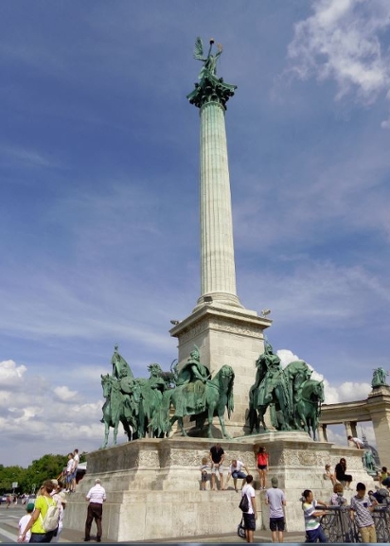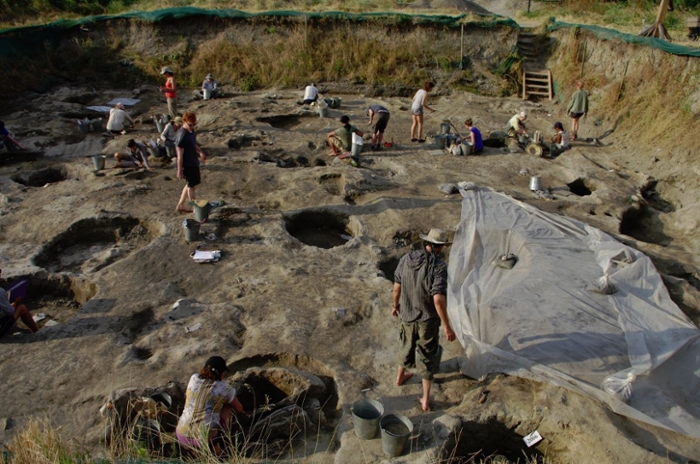
Catalin Popa’s Leiden experience: “Archaeology needs to contribute to society.”
Originally from Romania, Catalin Popa has been working at our Faculty as a Postdoc for two years now. He is a landscape archaeologist with a deep interest in the role of archaeology in society. “We should also produce a message for non-academics. One that is shaped for people that don’t have the time to do the research.”
Landscape perception
Catalin did his undergraduate in Romania, in Cluj-Napoca, a city in Transylvania. After that he went for a master to Cambridge, got a couple of grants, and stayed there for more than five years if you also consider his PhD studies. “I was specialising in the Late Iron Age of Europe, with a focus on identity and landscape use.” After finishing his PhD, Catalin worked for two years at the University of Berlin focusing on landscape perception. “And from Berlin, two years ago I moved to Leiden.” At our Faculty of Archaeology he investigates how people make decisions in the landscape based on statistical analyses.
Stars aligned
But why did he move to Leiden? That turned out to be a social factor. “I was not even halfway through my research from Berlin and I got an email from Maikel Kuijpers.” Maikel and Catalin did their PhD together in Cambridge and became good friends. “He told me he was in this project with David Fontijn, whom I had already met, and that there was a vacancy.” Catalin did not need much convincing. “I remembered that Maikel and I worked really well together during our PhD since we would bounce ideas between each other a lot.” So he applied for the job and was hired. “When all the stars aligned, I came here.” Now he is sharing an office with Maikel.
New directions
At first daunted by the size of the Faculty of Archaeology, Catalin soon found his way. “I like that I was able to have the opportunity to explore the different directions that I was interested in, in terms of research as well as teaching.” Making use of the heritage expertise in the Faculty, Catalin himself got into teaching heritage. “That seems the direction that I am going towards now.” Looking over the boundaries of the World Archaeology department, Catalin worked together with Sada Mire. “It was nice to step outside of my own department, in particular when there is someone that is willing to work together with you.”
Two roads
At this point, Catalin’s research is taking two different roads. “I do statistical modeling, investigating if we can see if there is a pattern in which bronze depositions appear in Western Europe.” He is applying his expertise on the Bronze Age people’s experience of the environment, while conscious of the fact that measurements can be too exact to actually be informative. “You may put a lot of emphasis on slope inclination for example, but if it is too detailed you are actually losing the idea that persons walking through that landscape are unable to physically see these differences that we include in our calculations.”
At the same time, he is working and publishing on the political dimension of archaeology. “I am looking at how the past can be useful in solving today’s challenges and how archaeologists can play a role in this.” Catalin teaches an honors class called ‘The Politics of the Past’. “I am teaching this course with Maja Vodopivec from Leiden University College in The Hague.” The class turned out to be very popular.

The relevance of archaeology
Catalin is more and more working on this topic. “It is not just about how we get all this information about the past, but more what we do with it and for what purpose.” He stresses that archaeology needs to be relevant to today’s people. “The current political developments, in Europe and beyond, are not very promising. I believe archeology needs to be present in the public debate. We need to contribute to helping society.”
This is now being translated into a project by Catalin and Maikel. “We are applying for exploring this dimension of how archeology can work together with businesses in the private sector in order to produce particular stories about the past that can help people deal with today’s societal challenges.” For example anxiety towards migration. “It is proving to be harder than we thought, because we need to reach out to businesses and, as academics, we are not trained for that." He is sure that this project would actually produce something that will have a direct impact on people that don’t have the time to read academic papers.
Public debate
Catalin wants the archaeologists to be present in the public debate, but as he explains, this is not a new idea. “This happened a lot 50-60 years ago. But archeology was often more related to the ideas of the right, so people became very anxious about it. And understandably so.” He explains that the past can also be used for positive examples. “The archaeological record shows that Europe has always been a melting pot. European culture is actually a product of all this mixing.”
But what would the role of businesses be? “Companies actually rely considerably on the past in order to inform their decisions. Moreover, if you are able to link what you are producing to a particular narrative of the past it reinforces you on the market.” Catalin also stresses the outreach capacities of businesses. “But I don’t want to disclose the whole thing, because this is a project that we are going to apply for.”
“This is not supposed to be here”
Meanwhile, Catalin is annually going on fieldwork to the Hungarian site of Százhalombatta, just south of Budapest, together with Maikel and some students. “It’s a Bronze Age tell site that people have inhabited for 1,000 years.” The project started some twenty years ago. Due to the site’s strategic location, it was thought that it must have been the residence of a chief. “Until now, we have little evidence that it was a big and important site. Actually, what we are experiencing is that it was a village with a fantastic vantage point.”
The team regularly encounters hard to explain features in the site. “For instance, two years ago in an area that Maikel was working on, we found a human skull sitting on top of a pit.” There were no traces of burials, the village’s cemetery being in a valley close-by, and, moreover, the inhabitants cremated their dead. “And suddenly there was a skull. And we were just sitting there, looking at it, and like ‘why is this here?’, ‘this is not supposed to be here’. The site gives you many of this crack your head moments.”

Pass on the trowel
In this series we ask a staff member to pick a colleague of whom they would like to know more. Sada Mire passed on the proverbial trowel to Aris Politopoulos MA. He will be interviewed for the newsletter of November 2018.
